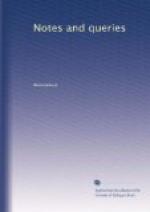“And here was showed a Book, written not long before the Queen’s death, at what time Thomas Winter was employed into Spain, entituled, ‘A Treatise of Equivocation,’ which book being seen and allowed by Garnet, the superior of the Jesuits, and Blackwell, the Archpriest of England, in the beginning thereof Garnet with his own hand put out those words in the title of ‘Equivocation,’ and made it thus; ’A Treatise against Lying and fraudulent Dissimulation.’ ... And in the end thereof, Blackwell besprinkles it with his blessing, saying, ’Tractatus iste valde doctus, et vere pius et Catholicus est. Certe S. Scripturarum, patrum, doctorum, scholasticorum, canonistarum, et optimarum rationum praesidiis plenissime firmat aequitatem aequivocationis; ideoque dignissimus est qui typis propagetur, ad consolationem afflictorum Catholicorum, et omnium piorum instructionem.’”
Coke referred to it again at Garnet’s trial, March 28, 1606 (State Trials, vol. ii. p. 234.); and the importance attached to the discovery of the work may be judged of by Morton’s Full Satisfaction, 1606: a very large part of which is occupied in discussing it.
The copy in the Bodleian is the one which was produced at the trial. It is a small quarto in a vellum cover, on the outside of which is written, on the front side, in a later hand, “Blackwell de Equivocatione, &c.;” on the other side, in Sir E. Coke’s hand, “Equivocations.” It consists of sixty-six pages in all; i.e. two leaves at the beginning originally left blank, and not numbered; sixty-one pages numbered continuously, and fifty-nine of them written on: p. 61., that is, the fly-leaf at the end, contains Blackwell’s imprimatur as described by Coke. On the first fly-leaf, at the beginning, is the following memorandum:—
“This booke, contening 61 pages, I founde in a chamber in the Inner Temple, wherein Sr Thomas Tresham used to lye, and whiche he obteyned for his two younger sonnes. This 5 of December, 1605.” EDW. COKE.
“Os quod mentitur occidit animam.”
It may be enough to remind the reader, that after Nov. 5, 1605, Coke, being Attorney-General, was engaged in prosecuting the discovery of the plot and seeking for evidence. Francis Tresham, to whom the authorship is attributed by Dodd (vol. ii. p. 427, 428.), was a son of Sir Thomas Tresham; his connection with Garnet and the plot is well known. Sir T. Tresham died Sept. 11, 1605. (Dodd, vol. ii. p. 58.) Francis had been committed {169} to prison, and died Nov. 20, 1605; and Coke found this in searching his chambers a fortnight after. The title originally stood thus:—




